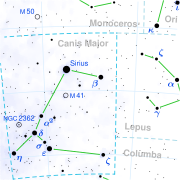Portal:Ancient Egypt/Selected article/7

Sirius is the brightest star in the night sky. With a visual apparent magnitude of −1.46, it is almost twice as bright as Canopus, the next brightest star. Known in Ancient Egypt as Sopdet, it is recorded in the earliest astronomical records. During the era of the Middle Kingdom, Egyptians based their calendar on the heliacal rising of Sirius, namely the day it becomes visible just before sunrise after moving far enough away from the glare of the Sun. This occurred just before the annual flooding of the Nile and the summer solstice, after a 70-day absence from the skies.
The hieroglyph for Sothis features a star and a triangle. Sothis was identified with the great goddess Isis, who formed a part of a trinity with her husband Osiris and their son Horus, while the 70-day period symbolised the passing of Isis and Osiris through the duat (Egyptian underworld). Ptolemy of Alexandria mapped the stars in Book VII and VIII of his Almagest, in which he used Sirius as the location for the globe's central meridian. He curiously depicted it as one of six red-coloured stars